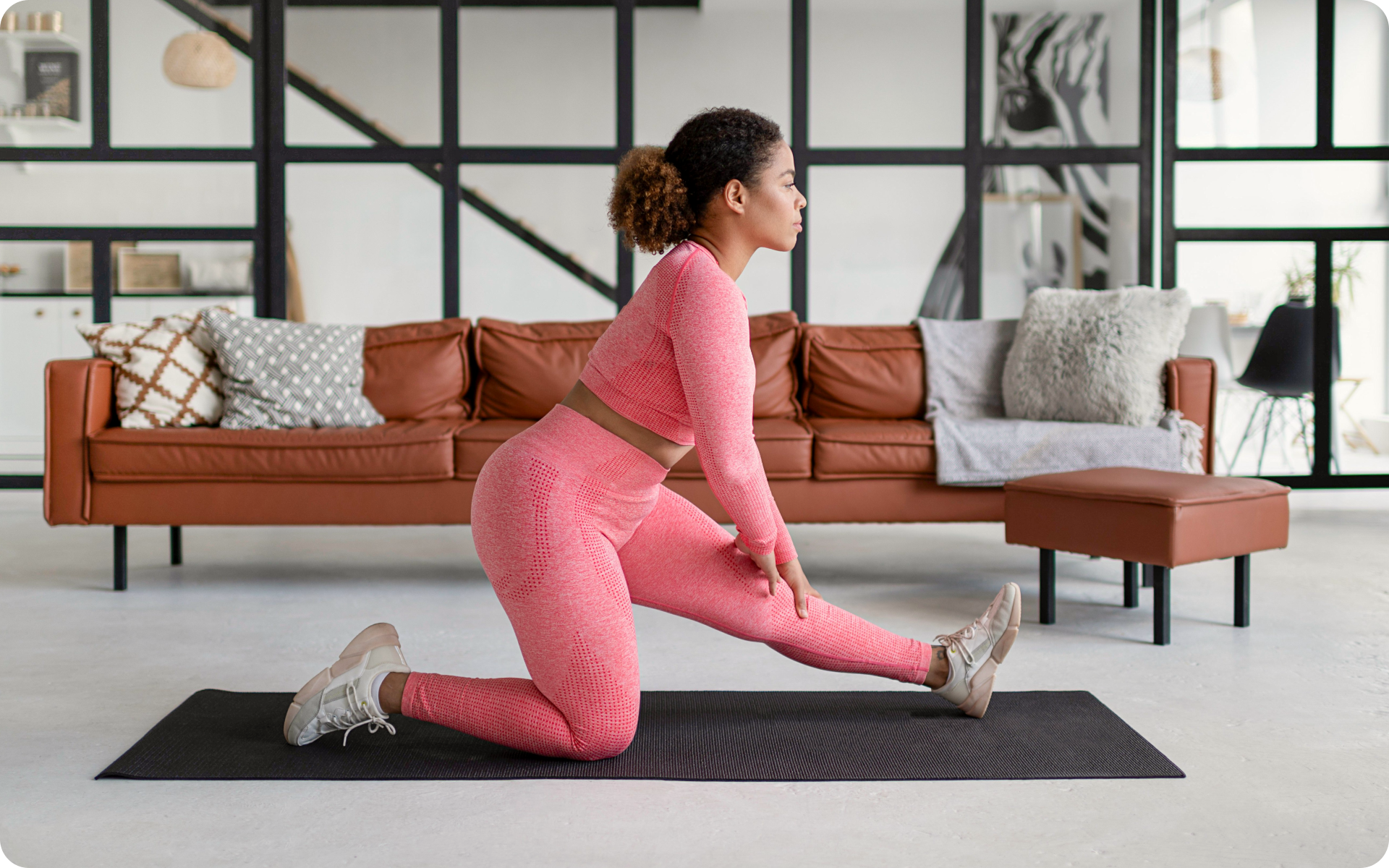What if I told you that you could lose 10 pounds in a month without feeling hungry and sad all the time? You can try a method where each step will make you closer to your goal weight. It’s a fun journey where you don’t restrict yourself too much and end up in the hospital (or a psychotherapist’s office…or both). When you get to the basics, it’s not that difficult if you have the right recommendations and specialists on your side, if you have pre-existing conditions. There are cases when weight loss becomes hard and even close to impossible, but we’ll focus on regular overweight people here. If you need extra help, make sure to consult a professional to build an individual plan for you. So, how much weight can you lose in a month? The Centers for Disease Control and Prevention (CDC) says 1-2 pounds a week is safe. So, up to 8 pounds is a-okay, but we’ll stretch it a little bit to 10. With some extra activity, you should be able to make those last 2 pounds without risks for your health. Don’t go for more if you don’t want to end up regaining even more weight on your shoulders (and hips).
Get your personalized
meal plan!
Why Losing Weight Fast Is NO GOOD
I wrote that in caps so it really settles in.
Yo-yo dieting is what many people think ‘weight loss’ is. They don’t even want to attempt it because they have heard about the struggles people go through, being hungry and tired all the time. And, in the end, all the pounds come back with some extra friends.
When you restrict your calorie intake too much, you are likely to experience:
- Muscle loss
- Nutritional deficiencies (12)
- Gallstones
- Metabolism drop
When your body recognizes that it isn’t getting enough energy, it reduces the amount of energy it uses to conserve what reserves it has. This “slowing” of metabolism may lead to weight gain even if you come back to the calorie limit that used to be your maintenance limit.
When your body lacks energy, it starts getting it elsewhere. While we’d love to think fat is the only choice, it’s actually not true. Muscle loss can be a side effect of rapid weight loss, which may leave you slimmer but with no real decrease in fat tissue. Muscles and water will diminish, though. Imagine the quality of your body without the muscle mass you already have.
That said, limit your weight loss goal in a month to 8-10 pounds and not more, otherwise you may end up with even more weight and health problems.
Read More: Running For Weight Loss: Dos And Don’ts For Beginners
The Best Way To Lose Weight: Preparation
These are optional, but I think that the mental part of weight loss is just as important. We often use food as a substitute for stress relief activities, comfort, attention, and even love. But this is a topic for another article.
Consider preparing mentally for your weight loss journey:
-
Set A Goal
By officially setting your goal, you solidify your ambitions and really commit. Calculate how much weight you want to lose and by when. In our case, it’s 10 pounds in a month, so about 2,5 pounds a week.
Write it down in weeks, create a plan with clear steps, meals, workouts, etc. The planning itself is super-exciting!
-
Take Measurements
Take your point A measurements. The main ones are the measurements of your chest and hips (the most voluminous points on both) and your waist. You can also measure a thigh and an arm (or both thighs and arms) for a more precise tracking.
Take such measurements every week, but don’t anticipate dramatic changes right away. Trust the process.
-
Start A Journal
To organize all that, you’ll need a journal. This will prove your commitment and help you track your progress. It can be a physical journal or just a neatly designed Google Docs or Sheets file.
Write down your goal, plan, measurements, thoughts, concerns, etc. Add anything you want, make it a real personal journal where you can do and say anything during your journey and beyond.
Actually, monitoring your food intake can be by itself an effective contribution to your weight loss efficacy (8). However, if you have a history of an eating disorder and may be triggered if you have to write down something you’ve eaten, talk to your healthcare team about better options for you.
And now, to fill your journal with actual effective weight loss ways, let’s find out how to lose 10 pounds in a month!
Looking for a way to break the vicious cycle of weight loss and tone up all the jiggly parts? Watch the extra pounds fly off and your muscles firm up with the BetterMe app!
Weight Loss Tips: 15 Ways To Lose 10 Pounds In A Month
Pro tip: make sure you enjoy your journey. Otherwise after a month you’ll come back to the old habits, gaining all the weight and struggles back. And, of course, don’t compare yourself to anyone. You are a unique soul in a unique body, and you already look good.
We focus on health here.
OK, let’s go.
#1: Include Cardio Into Your Training
Cardio, also called aerobic training or aerobic exercise, works by increasing your heart rate, resulting in a stronger calorie burn. It’s also useful for strengthening your cardiovascular system and lungs.
Cardio training of any kind should be a part of your routine. If you don’t like running or are getting dizzy when doing burpees, there are other ways like jogging or even fast walking. According to a study, with a balanced diet and 3 cardio training sessions a week, people can lose 9% of their body weight in 6 months.
You can choose from a variety of activities, including but not limited to:
- Boxing
- Biking
- Jogging
- Swimming
- Walking
If you don’t feel good after the workout, consult a doctor to find out what the issue is. And start with lighter workouts not to stress your body too much.
#2: Start Tracking How Much You Eat
You can count calories, portions, use the plate method, etc. Do whatever is more convenient for you. However, keep in mind that frantic calorie-counting may lead to psychological issues and even trigger an eating disorder since you may feel guilt every time you eat an extra piece. A study has shown that 75% of participants with a diagnosed ED used calorie trackers.
It’s very easy to develop some sort of disordered eating behavior if you’re constantly critical of yourself. So, please, be gentle on yourself and realize that our life consists of ups and downs and it’s OK if you eat something you were not supposed to every once in a while. Don’t restrict yourself too much.
Some sort of tracking can be helpful, though, because humans are very bad at eye-measuring how much they eat, especially when they try to lose weight. Portion tracking is really good for this. You don’t have to do it forever, just long enough for you to be able to better eyeball your portions and understand how much energy and nutrients the foods you are eating contribute to your diet.
#3: Try Eating Slowly
Make it a meditation. Thank your food for nourishing you and really taste every bite. Find new combinations and enjoy them. Switch off the TV, put your phone aside, and give yourself time to make this meal a true experience rather than a bite on the go.
First of all, if you do this, you’ll become mindful of what you eat and how it benefits your body. Then, eating slowly will make you feel full faster, which will decrease your overall calorie intake.
According to a study, women who ate slowly decreased their calorie intake by ~10% on average, felt clearer about when they should stop, and increased water consumption. Hey, it’s just about time to take smaller bites and drink plenty of water throughout the meal.
Read More: Weight Loss For Seniors: What Is The Best Way For Seniors To Lose Weight?
#4: Focus On Protein For Breakfast
Opting for protein at breakfast will help you feel full for a longer time and avoid snacking. Protein is an important macronutrient that helps you build muscle and decrease body fat as it’s digested for a longer time than other nutrients.
Studies suggest that by eating more protein long-term, you can amplify your weight loss efforts and reduce belly fat.
Besides, the diversity of protein foods is incredible. Add eggs, yogurt, cottage cheese, peanut butter, tofu, and other sources of protein to your foods. And if you eat meat, there are even more options.
#5: Limit Your Refined Carb Intake
Eating fewer carbs can help some people lose weight. This is especially true about refined carbs, as they come without fiber or nutrient value and won’t tame your hunger for a long time.
Moreover, such carbs tend to elevate blood sugar more quickly (13).
Choose whole grains instead of refined, and opt for more starchy vegetables and legumes. Whole grains will not only improve your fiber intake but open new, richer taste combinations as well.
#6: Optimize Your Fiber Intake
Fiber is irreplaceable when it comes to weight loss. It not only moves undigested through your digestive system which is good for your gut bacteria and promotes regularity, but it also performs important tasks (15), such as:
- Blood sugar balance
- Slow stomach emptying
- Keeping you full
By adding fruits and veggies, whole grains, and legumes to your diet, you not only help your body balance blood sugar and digest food better but also boost weight loss.
#7: Definitely Do Resistance Training
How to lose weight fast without exercise in a month? Just diet. You can lose plenty of weight through proper nutrition, but what body quality will you get at the end?
Resistance training boosts metabolism and builds muscle. Toned muscles will make your body look much better. Besides, such training burns a lot of calories, which is a plus for your calorie deficit.
A study showed that performing resistance training for 9 months made participants’ bodies burn an average of 5% more calories a day while resting. Tone your muscles and even when they are at rest, they burn more kcal for you, boosting fat loss.
#8: Mind What You Drink
Do you know what is the best beverage to drink during the day? Water! Increase your water intake. You can drink 8 glasses a day or even more, or calculate your own body needs. Just make sure you stay hydrated with clean water, not just coffee, juices, and sodas.
We don’t pay enough attention to what we drink. A soda during lunch or with a snack, a glass of juice in the morning because it’s considered ‘healthy’ and ‘clean’, some cocktails with friends on a Friday night because you want to have fun…
This sounds good and there’s nothing wrong with having some fun with your friends, but you could definitely tone it down calorie-wise:
- Instead of soda, choose sparkling or regular water.
- Put one sugar cube instead of two into your morning coffee and then switch to unsweetened.
- If you like juice, opt for a freshly squeezed natural one rather than store-bought; it may contain added sugar and other preservatives.
- Choose light beer or wine during night-outs and mind how much you drink. All alcohol contains calories, but many cocktails consist of sugary sodas plus calorie-heavy alcohol; that’s no good.
If you tend to let yourself off the hook, raise the white flag when things get tougher than you expected, send yourself on an unconscious binge-eating trip – BetterMe app is here to help you leave all of these sabotaging habits in the past!
#9: Increase Your Veggie Intake
Veggies are rich in nutrients, including antioxidants, vitamins, minerals, and fiber. Plus, they contain minimal calories. Not to mention they are incredibly delicious and can make any meal better.
There’s also a theory that the more colors you choose for your meals, the better. Such dishes also look aesthetically appealing, so why not?
Actually, there was a study that showed weight loss of 1.1 pounds in 6 months just by eating an extra 100 grams of veggies every day. That’s without special dieting, exercise, etc.
#10: Try Getting Plenty Of Sleep
I know, it’s like saying “Just don’t get stressed!”
But it’s possible to scooch at least an hour more to your snooze if you’re sleeping less than 7 hours a night. Cut your phone time before bed, don’t drink that afternoon coffee, and give your body enough time to recover from the strain of the day, especially if you had a workout.
Muscles recover and build at night while your whole body is rebooting to start a new day properly. Try to get some sleep, preferably before midnight.
Sleep also influences your hunger. A study confirmed that sleep deprivation makes you hungrier the next day.
#11: Consider Trying Intermittent Fasting
Intermittent fasting is a method of fasting for 14-24 hours (some say 12, some say 16) to let your body have a rest, balance blood sugar, and limit your calorie intake. This can become your power move when it comes to weight loss.
It’s as effective as any other method of achieving a calorie deficit, but it’s more fun for some people when you count the hours. First of all, you sleep for 7-8 hours (hopefully). That leaves you with 6 or more hours to wait until you can eat for the first time. Your morning routine, light training, and the first part of a working day can neatly fit into this time slot.
#12: Try Moving More During The Day
Walking, shaking your legs, stretching on your way to the bathroom, fidgeting, even typing makes you burn calories. All these activities join into a system called NEAT – non-exercise activity thermogenesis.
NEAT can make up half of the energy you use during the day (16). How many calories you’ll burn by doing non-exercise activities depends only on you. Try to move more during the day: park a little further away, take the stairs, stretch during your lunch break, organize your table more often, clean, cook, type, fidget. The options are plenty.
#13: Limit Or Adjust Your Sauce And Condiment Intake
Even if you see ‘light sauce’ on the bottle, that doesn’t mean it’s not packed with added sugars or other things you may want to avoid. Even soy sauce which seems innocent is packed with sodium, which many people choose to limit in their diets.
Read the labels carefully and try to minimize your condiment and sauce intake. Ask for them on the side and lightly sprinkle your salad. Or make them yourself so you know what goes into them. By doing so, you will lighten your daily calorie intake a lot.
#14: Relieve Stress Regularly
Have you heard about stress-eating?
Maybe you have even done it. When stressed, we can eat half the fridge without even realizing it. Not only this, stress influences your health dramatically, and not in a good way.
Cardiovascular diseases, diabetes, autoimmune diseases, cancers, etc. may all have stress as one of their contributors (14).
Let go of stress regularly, don’t wait for it to turn into a disease and contribute to excess weight.
#15: Include HIIT (High-Intensity Interval Training) Into Your Routine
HIIT can help you diversify your workout routine and boost fat loss. Even if you have one such training in a week, it will add up to all the effort you put into weight loss and body toning.
Summary
There’s no single best way to lose weight. You’ll have to work on a combination of actions to maintain a healthy body and shed those extra pounds. And this way is both general and individual. The general part is that you will need:
- A calorie deficit
- Physical activity
- Healthy nutrition
The individual factors are:
- The number of kcal to cut
- The foods to say no to
- The activity(ies) of your choice
- The goals you set, etc.
For a fit, toned, lighter body, you can try lots of diets including keto, paleo, intermittent fasting, etc. You can also drop all that and adopt balanced eating where you don’t place any harsh restrictions but keep the macro and micronutrient ratios healthy.
You can choose to dance every day or walk in a park as an additional or starting activity. You can do boxing and HIIT or yoga and pilates, or even all of them if you’d like.
You also can change the course of your journey by choosing new ways to be active and new tricks to get used to the new lifestyle.
The key is to be consistent with this lifestyle. I know this phrase is in almost every article here but you have to remember this. Be consistent with your balanced eating and regular training and trust the process.
In a month, you’ll see the first changes. In two-three months, others will notice just how fitter and glowier you’re becoming. You can get rid of all the excess weight that’s hanging on you, weighing you down (if you want to, of course). Just do it healthily!
DISCLAIMER:
This article is intended for general informational purposes only and does not serve to address individual circumstances. It is not a substitute for professional advice or help and should not be relied on for making any kind of decision-making. Any action taken as a direct or indirect result of the information in this article is entirely at your own risk and is your sole responsibility.
BetterMe, its content staff, and its medical advisors accept no responsibility for inaccuracies, errors, misstatements, inconsistencies, or omissions and specifically disclaim any liability, loss or risk, personal, professional or otherwise, which may be incurred as a consequence, directly or indirectly, of the use and/or application of any content.
You should always seek the advice of your physician or other qualified health provider with any questions you may have regarding a medical condition or your specific situation. Never disregard professional medical advice or delay seeking it because of BetterMe content. If you suspect or think you may have a medical emergency, call your doctor.
SOURCES:
- Aerobic or Resistance Exercise, or Both, in Dieting Obese Older Adults (2017, pubmed.ncbi.nlm.nih.gov)
- A single night of sleep deprivation increases ghrelin levels and feelings of hunger in normal-weight healthy men (2008, pubmed.ncbi.nlm.nih.gov)
- Eating slowly led to decreases in energy intake within meals in healthy women (2008, pubmed.ncbi.nlm.nih.gov)
- Effect of resistance training on resting metabolic rate and its estimation by a dual-energy X-ray absorptiometry metabolic map (2014, pubmed.ncbi.nlm.nih.gov)
- Gallstones (n.d., niddk.nih.gov)
- High intake of fruits and vegetables predicts weight loss in Brazilian overweight adults (2008, pubmed.ncbi.nlm.nih.gov)
- Intermittent fasting and weight loss (2020, ncbi.nlm.nih.gov)
- Log Often, Lose More: Electronic Dietary Self-Monitoring for Weight Loss (2019, onlinelibrary.wiley.com)
- Long-term effects of increased protein intake after weight loss on intrahepatic lipid content and implications for insulin sensitivity: a PREVIEW study (2018, pubmed.ncbi.nlm.nih.gov)
- Losing Weight (n.d., cdc.gov)
- My Fitness Pal Calorie Tracker Usage in the Eating Disorders (2017, ncbi.nlm.nih.gov)
- Prevalence of micronutrient deficiency in popular diet plans (2010, ncbi.nlm.nih.gov)
- The concept of low glycemic index and glycemic load foods as panacea for type 2 diabetes mellitus; prospects, challenges and solutions (2016, ncbi.nlm.nih.gov)
- The effects of chronic stress on health: new insights into the molecular mechanisms of brain–body communication (2015, ncbi.nlm.nih.gov)
- The impact of soluble dietary fibre on gastric emptying, postprandial blood glucose and insulin in patients with type 2 diabetes (2014, pubmed.ncbi.nlm.nih.gov)
- The Role of Non-exercise Activity Thermogenesis in Human Obesity (2018, ncbi.nlm.nih.gov)













